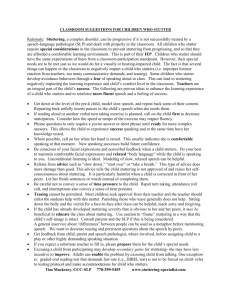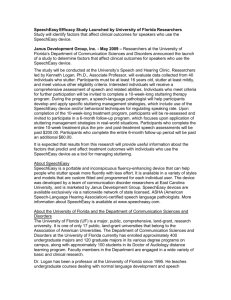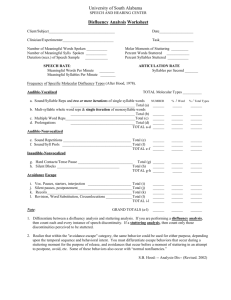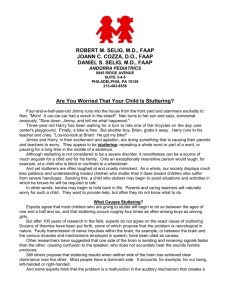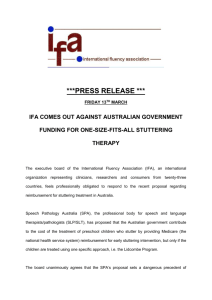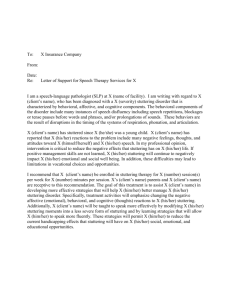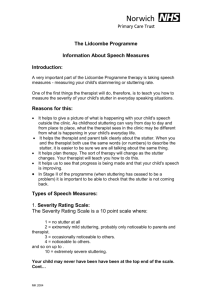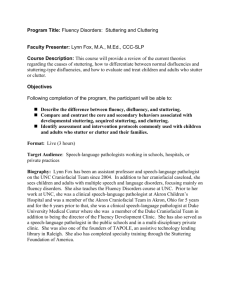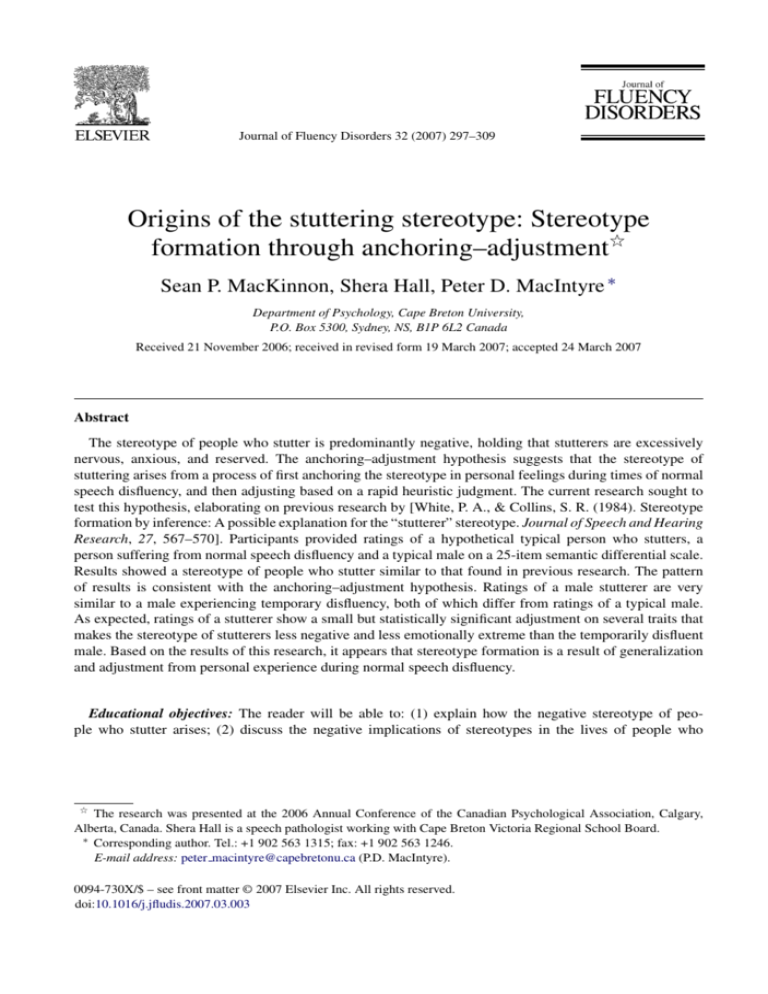
Journal of Fluency Disorders 32 (2007) 297–309
Origins of the stuttering stereotype: Stereotype
formation through anchoring–adjustment夽
Sean P. MacKinnon, Shera Hall, Peter D. MacIntyre ∗
Department of Psychology, Cape Breton University,
P.O. Box 5300, Sydney, NS, B1P 6L2 Canada
Received 21 November 2006; received in revised form 19 March 2007; accepted 24 March 2007
Abstract
The stereotype of people who stutter is predominantly negative, holding that stutterers are excessively
nervous, anxious, and reserved. The anchoring–adjustment hypothesis suggests that the stereotype of
stuttering arises from a process of first anchoring the stereotype in personal feelings during times of normal
speech disfluency, and then adjusting based on a rapid heuristic judgment. The current research sought to
test this hypothesis, elaborating on previous research by [White, P. A., & Collins, S. R. (1984). Stereotype
formation by inference: A possible explanation for the “stutterer” stereotype. Journal of Speech and Hearing
Research, 27, 567–570]. Participants provided ratings of a hypothetical typical person who stutters, a
person suffering from normal speech disfluency and a typical male on a 25-item semantic differential scale.
Results showed a stereotype of people who stutter similar to that found in previous research. The pattern
of results is consistent with the anchoring–adjustment hypothesis. Ratings of a male stutterer are very
similar to a male experiencing temporary disfluency, both of which differ from ratings of a typical male.
As expected, ratings of a stutterer show a small but statistically significant adjustment on several traits that
makes the stereotype of stutterers less negative and less emotionally extreme than the temporarily disfluent
male. Based on the results of this research, it appears that stereotype formation is a result of generalization
and adjustment from personal experience during normal speech disfluency.
Educational objectives: The reader will be able to: (1) explain how the negative stereotype of people who stutter arises; (2) discuss the negative implications of stereotypes in the lives of people who
夽 The research was presented at the 2006 Annual Conference of the Canadian Psychological Association, Calgary,
Alberta, Canada. Shera Hall is a speech pathologist working with Cape Breton Victoria Regional School Board.
∗ Corresponding author. Tel.: +1 902 563 1315; fax: +1 902 563 1246.
E-mail address: peter macintyre@capebretonu.ca (P.D. MacIntyre).
0094-730X/$ – see front matter © 2007 Elsevier Inc. All rights reserved.
doi:10.1016/j.jfludis.2007.03.003
298
S.P. MacKinnon et al. / Journal of Fluency Disorders 32 (2007) 297–309
stutter; and (3) summarize why the stereotype of people who stutter is so consistent and resistant to
change.
© 2007 Elsevier Inc. All rights reserved.
Keywords: Stuttering; Anchoring; Adjustment; Stereotype; Stereotype formation; Heuristics
Previous research has indicated that personality traits assigned to people who stutter are
predominately negative, including traits such as shy, insecure, reticent, guarded, avoidant, introverted, quiet, hesitant, self-derogatory, nervous, tense, and afraid (Doody, Kalinowski, Armson,
& Stuart, 1993; Klassen, 2002; Lass et al., 1992, 1994; White & Collins, 1984). These negative
personality traits constitute a stuttering stereotype that has been shown in a variety of groups,
including teachers and other school staff (Crowe & Walton, 1981; Dorsey & Guenther, 2000; Lass
et al., 1992, 1994; Silverman & Marik, 1993; Yeakle & Cooper, 1986), residents of small communities (Doody et al., 1993), and parents (Crowe & Cooper, 1977; Fowlie & Cooper, 1978). Even
speech-language pathologists and clinicians have been shown to endorse the stuttering stereotype
(Cooper & Cooper, 1996; Kalinowski, Armson, Stuart, & Lerman, 1993; Lass, Ruscello,
Pannbacker, Schmitt, & Everly-Myers, 1989; Silverman, 1982), though one study shows that
stereotypical thinking appears to have lessened among speech-language therapists in the UK since
1985 (Crichton-Smith, Wright, & Stackhouse, 2003). The negative personality traits attributed to
stutterers may not be accurate (Bloodstein, 1995), yet they are prevalent and consistent, creating
elements of a social reality that people who stutter will encounter in their everyday lives.
Research on stereotypes has shown that negative stereotypes of minority groups can impact
their employment income (Stroh, Brett, & Reilly, 1992), increase their self-consciousness and
worry when alone in an majority group (Cohen & Swim, 1995), and cause them to withdraw from
activities in which society expects them to fail (Steele, 1992). Gabel, Blood, Tellis, and Althouse
(2004) conducted a survey of 385 university students and found that people rated stuttering as
having an overall negative effect on career opportunities. Moreover, Gabel et al. (2004) report that
many careers that require frequent oral communication (e.g., attorney, judge, guidance counselor,
etc.) were viewed as inappropriate choices for people who stutter. In a recent survey by Klein and
Hood (2004), one in five people who stutter said they were turned down for a job because of their
stuttering.
The presence of negative stereotypes has the potential to lead to poorer performance on tasks.
This may result from a fear of confirming others’ stereotypes, even if the stereotype target and
the people holding the stereotype are not in direct contact. This phenomenon, called stereotype
threat (Steele & Aronson, 1995), has been shown most often with racial stereotypes, but there is
no reason to believe that the effect is limited only to race. Daniels and Gabel (2004) state that
“. . .people who stutter are perceived as limited in the kinds of careers and activities in which
they can succeed. Such perceptions, which evolve when stuttering is assigned category status,
may limit educational, occupational, and social experiences, and potential life roles” (p. 205).
Given that processes such as stereotype threat can have an important impact on the personal
and professional lives of people who stutter, there is reason to be concerned about the potential
effects of negative public attitudes, especially if they are expressed as abstract representations
about groups. The assumptions about persons that are activated by categorical representations or
schemas are notoriously difficult to alter later on (Fiske & Neuberg, 1990).
In the case of stuttering, attempts to combat the negative stereotype would be aided by a better
understanding of the source of those stereotypes. Though most of the literature demonstrates that
S.P. MacKinnon et al. / Journal of Fluency Disorders 32 (2007) 297–309
299
negative attitudes about people who stutter exist, few studies have examined why these stereotypes
occur. We propose that this process reflects the operation of the anchoring–adjustment heuristic1
described in the influential work of Tversky and Kahneman (1974). The current research elaborates
on the notion that the stuttering stereotype is formed though inference from one’s own experience
with temporary disfluency (Doody et al., 1993; White & Collins, 1984).
White and Collins (1984) tested a hypothesis concerning the origin of the stuttering stereotype.
Their hypothesis was that normally fluent speakers interpret the experience of stuttering speakers
by referring to their own cognitive experiences when producing non-fluent speech (White &
Collins, 1984, p. 567). People who are usually fluent speakers exhibit stuttering-like behavior
when under stress, and in such situations, the speaker is perceived to be nervous, shy, anxious,
and self-conscious.2 Participants in the study by White and Collins (1984) were asked to rate
either (1) an adult male who stutters or (2) a normally fluent adult male speaker who starts to
stutter for a short time, after which he speaks fluently again. The minimum correlation obtained
by comparing the two ratings was 0.77 and the maximum was 0.92, both of which support the
notion that the stuttering personality stereotype might be formed by generalizing from one’s own
experiences when producing non-fluent speech.
A related view is offered by Doody et al. (1993) who suggested that the negative stereotypes
surrounding stuttering may originate though inference as “non-stutterers make judgments about
stutterers based on their own feelings when they themselves experience disfluent stuttering-like
speaking moments” (p. 369). In other words, normally fluent individuals may generalize the
internal feelings that accompany moments of temporary disfluency to the permanent personality
traits of individuals who stutter. Temporary disfluencies often occur when a person is nervous or
tense. It is possible that people generalize these feelings to individuals who stutter and assume
that they generally must be nervous and tense.
The theoretical account offered by previous researchers on the formation of the stuttering
stereotype (Doody et al., 1993; White & Collins, 1984) is somewhat incomplete. Missing is a
description of how and why this inference process is undertaken. In our daily lives, many of us will
encounter numerous strangers each week without taking the trouble to form categorical, stereotypical inferences about them. Why then do we form stereotypes of stutterers, and why are those
stereotypes so consistent among various groups of people mentioned in the opening paragraph
above? We propose a theoretical refinement by drawing on relevant literature in psychology on
the anchoring–adjustment heuristic and recent research on the reaction of non-stutters to persons
who stutter.
1. Stereotype formation through anchoring and adjustment
There is a considerable amount of research that suggests people often make an adjustment from
an existing anchor in order to reach a decision. The anchoring and adjustment heuristic is based
on Tversky and Kahneman’s (1974) seminal work on the use of heuristics in judgments. Later
research demonstrated the anchoring and adjustment heuristic in a variety of situations, including
estimating the number of victims of stroke in the United States (Morrow, 2002), decision-making
1 In psychological research, a heuristic is a simple and efficient “rule-of-thumb” that a person uses in order to expedite
the decision-making process, especially when facing complex problems or incomplete information.
2 Of course, the experience of trait stuttering is vastly different than the non-fluent experience of a fluent speaker. The
intention of the research by White and Collins (1984) or the current research is not to imply that these groups are similar,
but rather to illustrate how the stuttering stereotype is formed among persons who do not stutter.
300
S.P. MacKinnon et al. / Journal of Fluency Disorders 32 (2007) 297–309
in group environments (Rutledge, 1993), gambling estimates (Carlson, 1990), and answering
general knowledge questions (Strack & Mussweiler, 1997).
Perhaps the research in the area of anchoring–adjustment most relevant to the present research is
a series of studies conducted by Epley, Keysar, Bovan, & Gilovich (2004). Essentially, they suggest
that people adopt another person’s perspective by serially adjusting from their own perspective.
They conducted a series of five studies examining how people interpret ambiguous answering
machine (studies 1 and 2) and email messages (study 5), how they implicitly evaluate other
people based on head nodding or shaking (study 4) as well as looking at how participants gauged
the accuracy of other participants on a cola taste test (study 3). These studies revealed four
important points about perspective taking: (1) participants are slow to rate others’ perspectives as
different than their own; (2) egocentric biases increase under time pressure; (3) biases decrease
when rewards are offered for accuracy; and (4) adjustments from one’s own perspective tend to
be insufficient, because people stop adjusting from an anchor as soon as a plausible solution is
reached.
Guntupalli, Kalinowski, Nanjundeswaran, Saltuklaroglu, and Everhart (2006) suggest that the
stuttering stereotype is formed through a two-step process that is initiated by the perceiver’s
initial, uncontrolled, negative reaction to the speech patterns of a person who stutters. Using the
anchoring–adjustment heuristic to make sense of this automatic emotional reaction, the perceiver
first uses his or her understanding of the experience of temporary speech disfluency as an anchor
for judgments of the attributes of stutterers. Realizing that disfluency and stuttering experiences
are not necessarily one-and-the-same, the perceiver then quickly makes an adjustment to partially
account for the high intensity of the emotional experience during moments of disfluency. If this
account holds, then we would expect that ratings of stutterers would be quite similar to ratings
of a temporarily disfluent speaker, though a little less extreme, especially with respect to anxiety,
nervousness, and similar emotions.
2. The current study and hypotheses
The present study tests to see if the anchoring and adjustment processes can account for
stereotypical personality ratings attributed to trait stutterers. We asked persons who do not stutter
to provide ratings on a set of 25 traits for three hypothetical persons: (1) a typical male, (2) a
male who experiences temporary speech disfluency (state disfluent male), and (3) a male with a
permanent stutter (trait stutterer). Using hypothetical persons as exemplars allows us to activate
only the categories in which we are interested, without confounding them with specific, individual
attributes of speakers presented on videotape or audiotape that might impact the person perception
process (e.g., age and attractiveness of the speaker, tone of voice, content of speech sample, etc.).
To test the anchoring–adjustment account of stereotype formation, our hypotheses are as follows.
H1. Trait stutterers will be rated as having significantly more negative personality traits than the
typical male.
H2. There will be a strong correlation between ratings of the trait stutterer and state disfluent
male. This represents the anchoring phase of the process.
H3. Where differences in means between state and trait ratings exist, the ratings of the state experience will be more negative than the ratings of the trait stutterer. This represents the adjustment
phase of the process.
S.P. MacKinnon et al. / Journal of Fluency Disorders 32 (2007) 297–309
301
3. Method
3.1. Participants
Participants (N =183) included students from first, second, and third year psychology classes
at University X. Almost two-thirds of the sample was female (N = 122, 67%), 31% were male
(N = 56) and 3% did not state their sex (N = 5). The mean age was 20.9 years (S.D. = 4.85) with a
range of 18–50 years of age. Approximately 87% of participants were Caucasian (N = 159), 1%
were of African descent (N = 2), 1% were Aboriginal (N = 2), 6% identified themselves as “other”
(N = 11), and 3% did not state their ethnicity (N = 6).
3.2. Materials
Participants were first instructed to read a consent form after which participants were randomly
assigned to one of two groups. The first group was given two hypothetical people to rate. One
person was described as an adult male with an uncontrollable stutter (trait stutterer). The other
person was described as a “. . .normally fluent adult male speaker who suddenly begins to stutter
for a short period of time, after which he speaks fluently again” (state disfluent male). The order
of presentation for the two persons was randomized. The target person was described as male
because males are much more likely to stutter than females (Craig, Hancock, Tran, Craig, &
Peters, 2002). A second group of participants was asked to rate only the personality of a typical
adult male, with no mention at all of stuttering.
A 25-item semantic differential scale (Woods & Williams, 1976) was employed in order to
determine the ratings of a state disfluent male (α = 0.91), a trait stutterer (α = 0.90), and the typical
male (α = 0.82). This scale utilizes Likert scales of bipolar adjectives separated by 7 points. Each
point corresponds to a caption: 1 and 7 = very much, 2 and 6 = quite a bit, 3 and 5 = slightly, and
4 = neutral. Participants made ratings on each scale by circling one of the seven numbers. For
example:
Nervous 1–2–3–4–5–6–7 Calm
In this case, low scores indicate a nervous personality, while high scores indicate a calm
personality. Low scores will always correspond to the item on the left-hand side of the bipolar
pair. The midpoint of the scale (4) indicates no preference for either adjective. In the above
example, ratings less than 4.0 would indicate that the respondent rates the target person on the
“nervous” side; ratings above 4.0 would indicate that a respondent rates the target person as moreor-less “calm.” Given that low scores (e.g., 1) and high scores (e.g., 7) are assigned arbitrarily, it
would be just as meaningful if the numbers were reversed (i.e., if nervous was assigned a score
of 7 and calm was assigned a score of 1). Before computing the estimates of Cronbach’s alpha
reliability, and for use in Fig. 1, items were coded in the same direction so that high scores are
indicative of the stuttering stereotype. In recoding, a score of 7 is converted to a score of 1, 6
becomes 2, 5 becomes 3, and so on.
The final section of the questionnaire included demographic questions regarding age, gender,
ethnicity, and program of study.
3.3. Procedure
The present study was conducted during university class time. Participants were told that
participation was voluntary and that they did not have to answer any questions if they so chose.
302
S.P. MacKinnon et al. / Journal of Fluency Disorders 32 (2007) 297–309
Fig. 1. Stereotypical trait ratings of trait stutterers, state disfluent males, and typical males. Note: The 15 stereotypic
traits are plotted on the x-axis. For ease of interpretation, the polarity of 5 out of 15 of these stereotypical traits had to be
reversed so that high numbers would be indicative of a stereotypical response. For this reason, on recoded traits, the means
shown in Table 1 will not match those in the figure. The recoded traits are indicated with [r]. The traits shown in the figure
are as follows: (1) afraid–confident, (2) fearful–fearless, (3) nervous–calm, (4) tense–relaxed, (5) anxious–composed,
(6) self-conscious–self-assured, (7) shy–bold, (8) withdrawn–outgoing, (9) quiet–loud, (10) talkative–reticent [r], (11)
avoiding–approaching, (12) aggressive–passive[r], (13) daring–hesitant[r], (14) secure–insecure[r] and (15) bragging–selfderogatory[r].
Participants were instructed to read the consent form and place a checkmark in a box if they agreed
to participate. The study was introduced as a short questionnaire study, which included descriptions
of two hypothetical people along with the 25-item semantic differential scale, and demographic
questions. The questionnaires given to the experimental group were counterbalanced to reduce
the chance of order effects. Half were asked to rate the trait stutterer first and the other half were
asked to rate the state disfluent male first. The researcher briefly described the purpose of the study,
gave instructions concerning the rating scales (e.g., circle one point only), and then distributed
the questionnaires. Students were instructed not to collaborate or look at their neighbor’s ratings
during the questionnaire period. Participants were permitted to direct any questions regarding the
completion of the questionnaire to the researcher. The typical male was presented to a separate
group of raters both to avoid order effects and to prevent the control group from associating their
ratings of the typical male with stuttering.
4. Results
The differences between the trait stutterer and the typical male were examined first to assess
the nature of the stereotype of stutterers. The ratings were provided by two different groups
so a multivariate independent groups t-test was conducted. The test was first evaluated at the
multivariate level to control the overall type 1 error rate (see Tabachnik & Fidell, 1996). Pillais’ Trace = 0.45, F(25, 147) = 4.74, p < 0.001, partial η2 = 0.447. Before inspecting the 25 traits
S.P. MacKinnon et al. / Journal of Fluency Disorders 32 (2007) 297–309
303
individually, we lowered the alpha level from 0.05 to 0.002 based on a Bonferonni adjustment
(0.05/25). Compared to the typical male, the trait stutterer is significantly (p < 0.002) more nervous,
shy, self-conscious, tense, anxious, withdrawn, quiet, reticent, avoiding, fearful, passive, afraid,
hesitant, insecure, and self-derogatory. These 15 traits therefore can be considered stereotypical of
people who stutter. Participants in this sample showed no significant difference between the typical male and trait stutterers on the following 10 bipolar pairs: open–guarded, sensitive–insensitive,
introverted–extroverted, emotional–bland, cooperative–uncooperative, friendly–unfriendly,
pleasant–unpleasant, intelligent–dull, perfectionist–careless, and inflexible–flexible. Means and
standard deviations for each of the 25-scale items are presented in Table 1.
To test the anchoring portion of the anchoring–adjustment hypothesis, we computed the correlation between the state and trait ratings. Results show significant correlation between state and
trait ratings, r(147) = 0.55, p < 0.001. To further test the relationship between these two variables,
we also used White and Collins’ (1984) procedure, which involves correlating the mean ratings
of each personality trait. White and Collins offer the following when explaining the proper use of
this method:
The variance in the means across the scales [. . .] depends upon the relative polarity of the
scales. Changing nervous-calm to calm-nervous, for example, alters the variance in the
means across the scales. There is no “true” or “correct” arrangement of scale polarities, but
since the strength of the correlation is related to the amount of variance in the means, one
can calculate minimum and maximum correlations for the data obtained by arranging scale
polarities to minimize and maximize, respectively, the variance in means across them (p.
569).
Using this method, the minimum correlation between state and trait ratings in the present study
is r(23) = 0.79, p < 0.001, and the maximum correlation is, r(23) = 0.96, p < 0.001. These results
suggest that participants rated the state disfluent male and the trait stutterer in a highly similar
fashion.
Finally, to test the adjustment portion of the anchoring–adjustment hypothesis, we compared
ratings of the trait stutterer to the ratings of the state disfluent male. A multivariate paired t-test was
conducted to locate differences in the 25 means of trait and state ratings. At the multivariate level,
there was a significant difference between state and trait ratings, F(25, 118) = 3.98, p < 0.001,
partial η2 = 0.457. To examine this finding more closely, we inspected the univariate results.
Significant differences (p < 0.002) were observed for seven traits. In six of those seven cases,
where differences between the state and trait ratings were significant for individual items, the
ratings for the state disfluent male tended to be more extreme (i.e., closer to 1 or 7 on a Likert
scale) than the trait stutterer, consistent with our hypotheses (see Table 1 and Fig. 1). The only
anomalous case was for pleasant–unpleasant. The polarity of this item differs from the other six
items which all refer to anxiety-related traits (see Table 1). Therefore, we can summarize the
results by noting that in every instance of a significant difference in means between the state
disfluent male and the trait stutterer, the state disfluent male was always rated more negatively
and usually thought to be more anxious.
5. Discussion
The current research builds on previous findings that the stuttering stereotype is formed through
inference (Doody et al., 1993; White & Collins, 1984) by drawing on anchoring–adjustment
theory. Our results indicated that participants rated a male trait stutterer more negatively than a
304
Table 1
Mean differences on the semantic differential scale items (p < 0.05)
**
##
State [mean (S.D.)]
Trait [mean (S.D.)]
Typical male
[mean (S.D.)]
Compared to trait stutterer,
state stutterer is more
Compared to typical male,
trait stutterer is more
Afraid–confident
Fearful–fearless
Nervous–calm
Tense–relaxed
Anxious–composed
Self-conscious–self-assured
Shy–bold
Withdrawn–outgoing
Quiet–loud
Talkative–reticent
Avoiding–approaching
Aggressive–passive
Daring–hesitant
Secure–insecure
Bragging–self-derogatory
Cooperative–uncooperative
Friendly–unfriendly
Intelligent–dull
Perfectionist–careless
Inflexible–flexible
Sensitive–insensitive
Open–guarded
Emotional–bland
Introverted–extroverted
Pleasant–unpleasant
2.95 (1.29)
3.06 (1.21)
2.34 (1.26)
2.20 (1.14)
2.63 (1.36)
2.19 (1.22)
2.83 (1.30)
3.18 (1.37)
3.07 (1.27)
4.39 (1.64)
3.32 (1.23)
4.38 (1.21)
4.77 (1.25)
4.93 (1.44)
4.62 (1.06)
3.66 (1.32)
3.35 (1.31)
3.27 (1.33)
3.71 (1.08)
4.05 (0.95)
3.11 (1.19)
4.88 (1.44)
3.48 (1.05)
3.25 (1.13)
3.64 (1.26)
3.45** (1.26)
3.39** (1.32)
2.85** (1.45)
3.07** (1.33)
3.15** (1.36)
2.49 (1.41)
2.81 (1.23)
3.31 (1.34)
2.93 (1.26)
4.56 (1.36)
3.35 (1.24)
4.48 (1.12)
4.68 (1.27)
4.71 (1.33)
4.52 (1.01)
3.44 (1.31)
3.17 (1.37)
3.17 (1.38)
3.67 (1.04)
4.29 (0.98)
2.99 (1.11)
4.76 (1.38)
3.60 (0.98)
3.47** (0.97)
3.28** (1.34)
5.17## (0.89)
4.62## (1.35)
4.96## (0.98)
4.72## (1.19)
4.41## (1.18)
4.39## (1.52)
4.65## (1.37)
5.10## (1.18)
4.45## (1.38)
3.65## (1.56)
4.55## (1.50)
3.64## (1.35)
3.07## (1.16)
3.59## (1.38)
3.79## (1.59)
3.46 (1.32)
3.00 (1.44)
3.07 (1.22)
3.93 (1.51)
4.38 (1.47)
3.69 (1.47)
4.07 (1.33)
4.2 (1.32)
3.93 (1.10)
2.82 (1.23)
Afraid
Fearful
Nervous
Tense
Anxious
Afraid
Fearful
Nervous
Tense
Anxious
Self-Conscious
Shy
Withdrawn
Quiet
Reticent
Avoiding
Passive
Hesitant
Insecure
Self-derogatory
Significant difference (p < 0.002) between state stutterers and trait stutterers.
Significant difference (p < 0.002) between state stutterers and the typical male.
Introverted
Unpleasant
S.P. MacKinnon et al. / Journal of Fluency Disorders 32 (2007) 297–309
1
2
3
4
5
6
7
8
9
10
11
12
13
14
15
16
17
18
19
20
21
22
23
24
25
Likert scale item
S.P. MacKinnon et al. / Journal of Fluency Disorders 32 (2007) 297–309
305
typical male, replicating the negative stereotype toward those who stutter observed in other studies
(Doody et al., 1993; Klassen, 2002; Lass et al., 1992, 1994; White & Collins, 1984).
Participants appear to have anchored their judgments of people who stutter in their knowledge
about experiencing state disfluency. The ratings of male stutterers were highly correlated with
(from 0.79 to 0.96) ratings of males experiencing temporary speech disfluency, results that are
virtually identical to White and Collins’ (1984) findings. The strength of this relationship lends
credence to the idea that the stereotype surrounding persons who stutter results from first anchoring
in prior feelings during state disfluency.
Though the relationship between state and trait ratings was strong, there were still significant
differences between state and trait ratings on seven of the bipolar pairs. We suggest that this
represents the operation of an adjustment phase, where raters made some changes to their anchor
(in this case, feelings during state disfluency) when making a rating of people who stutter. The
direction of the adjustment is consistent. In all cases, the ratings of the state disfluent male were
more negative than ratings given to the trait stutterer. Specifically, the state disfluent male was seen
as more afraid, fearful, nervous, tense, anxious, introverted, and unpleasant. Participants seem
to be inferring that trait stutterers have adapted to the stuttering experience, but typically fluent
speakers, being accustomed to fluency, react to a greater degree when experiencing disfluency
(see Fig. 1). However, participants also appear to be underestimating the degree of difference
between a person experiencing temporary state disfluency and a person who has a permanent,
uncontrollable stutter.
There is not a strong reason to believe that the personality of a stutterer systematically differs
from a typical person, and this is supported by research (Bloodstein, 1995). Therefore, one would
expect that a person would use the typical male as a benchmark (i.e., anchor) and adjust their
perception of a person with stuttering from there. However, given the results of this study, it seems
that people actually use their feelings during temporary state disfluency as an anchor, and adjust
from that experience when making a personality judgment about a person with stuttering. People
will stop making adjustments before considering all the possible reasons for stuttering (Epley et
al., 2004). The effect of stopping too soon is to leave the ratings of stutterers as too similar to state
disfluency and not similar enough to the typical male. Heuristics such as anchoring–adjustment
often sacrifice accuracy for speedy cognitive processing (Fiske & Taylor, 1991).
6. Limitations and future research
One important limitation of this study is that the hypothetical persons used as examples in our
study were all male. Thus, we cannot determine with this data if male and female stutterers are
viewed differently by non-stutterers. Another possible limitation is that the study was conducted
with a fairly homogeneous sample and might not generalize beyond university students, though
our results are consistent with previous research in other groups. Finally, and most significantly,
it may be argued that the use of hypothetical persons may not reflect the process undertaken in
stereotyping a real person.
Hypothetical persons were used to examine the process of stereotyping by using abstract
categories rather than individual persons. This methodology limits the generalizability of the
results. We are unsure as to whether individuals would react in the same way to a real person as
they did to the written, hypothetical examples. For example, a study by Wenker, Wegner, and Hart
(1996) found that when viewed on videotape, disfluent speakers were rated as more trustworthy,
sincere, friendly, and having a better sense of humor when compared to a fluent speaker, a result
not corroborated by the data utilizing hypothetical persons. However, using hypothetical persons
306
S.P. MacKinnon et al. / Journal of Fluency Disorders 32 (2007) 297–309
as examples has merit in that the ratings are not confounded by the perceptions of a specific
individual who may be viewed as more or less attractive, friendly, boring, and so on. This allows
for an examination of the stereotype as an abstract category, and has been used in numerous studies
in the past (Doody et al., 1993; Dorsey & Guenther, 2000; Gabel, 2006; Lass et al., 1992, 1994;
White & Collins, 1984; Woods & Williams, 1976). The use of such categories does occur in daily
life. For example, impressions of persons who stutter are of particular importance in employment
seeking contexts, where stereotypical preconceptions can affect the treatment of a candidate for
a job. It would be interesting to conduct future research on the anchoring–adjustment process
in more naturalistic settings, such as with job applicants self-identified as stutterers. To make
results such as the ones from the present study more generalizable, and enhance confidence in
the description of the underlying processes, they must be replicated in the “real-world” settings
in which they are thought to apply.
Recent research has suggested that there may be another component involved in the creation
of the stereotype of people who stutter. There is some evidence that stereotypes can be activated
automatically at an unconscious level by merely perceiving the distinguishing features of the
stereotyped group (Bargh, 1994; Devine, 1989; for a review, see Bargh & Chartrand, 1999).
More specifically with respect to stuttering, Guntupalli et al. (2006) found that fluent adults have
an automatic increase in skin conductivity upon hearing stuttered speech. This physiological
measure indicates that fluent speakers become emotionally aroused when listening to the speech
of a person who is stuttering, without necessarily understanding why the arousal occurs. The
anchoring–adjustment process may be initially activated as an attempt to account for one’s own
spontaneous emotional arousal induced by listening to stuttered speech, which inadvertently
results in stereotyping persons who stutter. Future research would do well to focus further on the
automatic, negative evaluation that fluent speakers have toward stuttered speech in order to have
a more complete model of the stereotype formation of people who stutter.
Though often an automatic process, the stereotype surrounding persons who stutter may not be
inevitable. The anchoring–adjustment heuristic is used when people must make a quick decision.
A heuristic, like all “rules of thumb,” can be overridden by effortful cognition or by knowledge
of how heuristics operate. Savitsky and Gilovich (2003) have shown that the tendency to use
anchoring–adjustment can be overcome by informing participants about the heuristic, thus reducing its effect. This too, would be an interesting topic for future research. With enough knowledge
and elaborative thought within targeted groups, stuttering stereotypes may also be diminished.
Acknowledgement
This research was supported by a grant from the Social Sciences and Humanities Research
Council of Canada to the third author.
CONTINUING EDUCATION
Origins of the stuttering stereotype: Stereotype formation through anchoring–adjustment
QUESTIONS
1. Based on the findings of this research, the stereotype of people who stutter arises from:
a. lack of experience with people who stutter
b. generalization from feelings during moments of normal speech disfluency
S.P. MacKinnon et al. / Journal of Fluency Disorders 32 (2007) 297–309
2.
3.
4.
5.
307
c. stereotypical depictions of people who stutter in the media
d. a genuine difference in personality in people who stutter
e. none of the above
According to this paper, why is the stereotype of people who stutter so consistent across
populations and resistant to change?
a. because of ingrained socialization of stereotypical values
b. because the stereotype is accurate in describing people who stutter
c. because people generally feel anxious during moments of normal speech disfluency, and
they attribute those feelings to people who stutter
d. lack of experience with people who stutter, given the relatively low incidence rate
e. none of the above
Which of the following is potentially a negative outcome of the stuttering stereotype in the
lives of people who stutter?
a. rejection for employment in certain jobs
b. stereotype threat
c. avoidance of career choices based on their stuttering
d. false self-related beliefs
e. all of the above
Which automatic process is used when developing a perception of people who stutter, according
to this research?
a. person perception
b. anchoring–adjustment heuristic
c. fear of loss
d. availability heuristic
e. confirmation bias
By examining prior research by Guntupalli et al. (2006), one can infer that the quick, automatic evaluation process that occurs when stereotyping persons with stuttering is first initiated
by:
a. an automatic, negative physiological reaction upon hearing stuttered speech
b. schema activation from a plethora of negative media images regarding stuttering
c. a negative personal experience with a person who stutters
d. none of the above
e. all of the above
References
Bargh, J. A. (1994). The Four Horsemen of automaticity: Awareness, efficiency, intention, and control in social cognition.
In R. S. Wyer Jr. & T. K. Srull (Eds.), Handbook of social cognition (2nd ed., pp. 1–40). Hillsdale, NJ: Lawrence
Erlbaum Associates.
Bargh, J. A., & Chartrand, T. L. (1999). The unbearable automaticity of being. American Psychologist, 54(7),
462–479.
Bloodstein, O. (1995). A handbook on stuttering. San Diego, CA: Singular Publishing Group.
Carlson, B. W. (1990). Anchoring and adjustment in judgments under risk. Journal of Experimental Psychology: Learning,
Memory, and Cognition, 16, 665–676.
Crichton-Smith, I., Wright, J., & Stackhouse, J. (2003). Attitudes of speech and language therapists towards stammering:
1985 and 2000. International Journal of Language & Communication Disorders, 38(3), 213–234.
Cohen, L. L., & Swim, J. K. (1995). The differential impact on gender rations on women and men: Tokenism selfconfidence, and expectations. Personality and Social Psychology Bulletin, 21, 876–884.
308
S.P. MacKinnon et al. / Journal of Fluency Disorders 32 (2007) 297–309
Cooper, E. B., & Cooper, C. S. (1996). Clinician attitudes towards stuttering: Two decades of change. Journal of Fluency
Disorders, 21, 119–135.
Craig, A., Hancock, K., Tran, Y., Craig, M., & Peters, K. (2002). The epidemiology of stuttering in the community across
the entire lifespan. Journal of Speech Language and Hearing Research, 45, 1097–1105.
Crowe, T. A., & Cooper, E. B. (1977). Parental attitudes toward and knowledge of stuttering. Journal of Communication
Disorders, 10, 343–357.
Crowe, T. A., & Walton, J. H. (1981). Teacher attitudes toward stuttering. Journal of Fluency Disorders, 6, 163–174.
Daniels, D. E., & Gabel, R. M. (2004). The impact of stuttering on identity construction. Topics in Language Disorders,
24(3), 200–215.
Devine, P. G. (1989). Stereotypes and prejudice: Their automatic and controlled components. Journal of Personality and
Social Psychology, 56, 5–18.
Doody, I., Kalinowski, J., Armson, J., & Stuart, A. (1993). Stereotypes of stutterers and nonstutterers in three rural
communities in Newfoundland. Journal of Fluency Disorders, 18, 363–373.
Dorsey, M., & Guenther, R. K. (2000). Attitudes of professors and students toward college students who stutter. Journal
of Fluency Disorders, 25, 77–83.
Epley, N., Keysar, B., Bovan, L. V., & Gilovich, T. (2004). Perspective taking as anchoring and adjustment. Journal of
Personality and Social Psychology, 87, 327–339.
Fiske, S. T., & Neuberg, S. L. (1990). A continuum of impression formation, from category-based to individuating
processes: Influences of information and motivation on attention and interpretation. In M. P. Zanna (Ed.), Advances
in experimental social psychology (pp. 1–74). New York: Academic Press.
Fiske, S. T., & Taylor, S. E. (1991). Social cognition (2nd ed.). New York: McGraw Hill.
Fowlie, G. M., & Cooper, E. B. (1978). Traits attributed to stuttering and nonstuttering children by their mothers. Journal
of Fluency Disorders, 3, 233–246.
Gabel, R. M. (2006). Effects of stuttering severity and therapy involvement on attitudes towards people who stutter.
Journal of Fluency Disorders, 31, 216–227.
Gabel, R. M., Blood, G. W., Tellis, G. M., & Althouse, M. T. (2004). Measuring role entrapment of people who stutter.
Journal of Fluency Disorders, 29, 27–49.
Guntupalli, V. K., Kalinowski, J., Nanjundeswaran, C., Saltuklaroglu, T., & Everhart, D. E. (2006). Psychophysiological
responses of adults who do not stutter while listening to stuttering. International Journal of Psychophysiology, 62,
1–8.
Kalinowski, S., Armson, J., Stuart, A., & Lerman, J. W. (1993). Speech clinicians’ and the general public’s perceptions
of self and stutterers. Journal of Speech-Language Pathology and Audiology, 17, 79–85.
Klassen, T. R. (2002). Social distance and the negative stereotype of people who stutter. Journal of Speech-Language
Pathology and Audiology, 26(2), 90–99.
Klein, J. F., & Hood, S. B. (2004). The impact of stuttering on employment opportunities and job performance. Journal
of Fluency Disorders, 29(4), 255–273.
Lass, N. J., Ruscello, D. M., Pannbacker, M., Schmitt, J. F., & Everly-Myers, D. S. (1989). Speech-language pathologists’
perceptions of child and adult female and male stutterers. Journal of Fluency Disorders, 14, 127–134.
Lass, M. J., Ruscello, D. M., Pannbacker, M. D., Schmitt, J. F., Kiser, A. M., Mussa, A. M., et al. (1994). School
administrators’ perceptions of people who stutter. Language, Speech, and Hearing Services in Schools, 25,
90–93.
Lass, M. J., Ruscello, D. M., Schmitt, J. F., Pannbacker, M. D., Orlando, M. B., Dean, K. A., et al. (1992). Teachers’
perceptions of stutterers. Language, Speech, and Hearing Services in Schools, 23, 78–81.
Morrow, J. (2002). Demonstrating the anchoring–adjustment heuristic and the power of the situation. Teaching of Psychology, 29(2), 129–132.
Rutledge, R. W. (1993). The effects of group decisions and group-shifts on use of the anchoring and adjustment heuristic.
Social Behavior and Personality, 21(3), 215–226.
Savitsky, K., & Gilovich, T. (2003). The illusion of transparency and the alleviation of speech anxiety. Journal of
Experimental and Social Psychology, 39, 618–625.
Silverman, E. M. (1982). Speech-language clinicians’ and university students’ perceptions of stutterers. NSSLHA Journal,
17, 86–89.
Silverman, F. H., & Marik, J. H. (1993). Teachers’ perceptions of stutterers: A replication. Language, Speech, and Hearing
Services in Schools, 24, 108.
Strack, F., & Mussweiler, T. (1997). Explaining the enigmatic anchoring effect: Mechanisms of selective accessibility.
Journal of Personality and Social Psychology, 73, 437–446.
Steele, C. M. (1992). Race and the schooling of Black Americans. The Atlantic Monthly, 269(4 (April)), 68–78.
S.P. MacKinnon et al. / Journal of Fluency Disorders 32 (2007) 297–309
309
Steele, C. M., & Aronson, J. (1995). Stereotype threat and the intellectual test performance of African Americans. Journal
of Personality and Social Psychology, 69, 797–811.
Stroh, L. K., Brett, J. M., & Reilly, A. H. (1992). All the right stuff: A comparison of female and male managers’ career
progression. Journal of Applied Psychology, 77, 251–260.
Tabachnik, B. G., & Fidell, L. S. (1996). Using multivariate statistics. New York, NY: Harper Collins.
Tversky, A., & Kahneman, D. (1974). Judgment under uncertainty: Heuristics and biases. Science, 185, 1124–1130.
Wenker, R. B., Wegner, J. G., & Hart, K. J. (1996). The impact of presentation mode and disfluency on judgments about
speakers. Journal of Fluency Disorders, 21, 147–159.
White, P. A., & Collins, S. R. (1984). Stereotype formation by inference: A possible explanation for the “stutterer”
stereotype. Journal of Speech and Hearing Research, 27, 567–570.
Woods, C. L., & Williams, D. E. (1976). Traits attributed to stuttering and normally fluent males. Journal of Speech and
Hearing Research, 19, 267–278.
Yeakle, M. K., & Cooper, E. B. (1986). Teacher perceptions of stuttering. Journal of Fluency Disorders, 11, 345–359.
Sean P. MacKinnon lives in Sydney, Nova Scotia, and has completed his B.A. (Hon.) in psychology from Cape Breton
University. He has received a silver medal for the highest graduating average in the B.A. program at the university and is
currently working as a research assistant at CBU.
Shera Hall is a speech-language pathologist with Cape Breton Victoria Regional School Board. She received her undergraduate degree in psychology from Dalhousie University and completed her undergraduate honours thesis at Cape
Breton University. In 2005, she received her M.Sc. in human communication disorders (speech-language pathology) from
Dalhousie University.
Peter D. MacIntyre is a professor of psychology at Cape Breton University. He received his undergraduate degree from
that institution before attending the University of Western Ontario, where he received his Ph.D. in 1992. From 1992 to
1994, he held the position of a Post Doctoral Research Fellow at the University of Ottawa.



